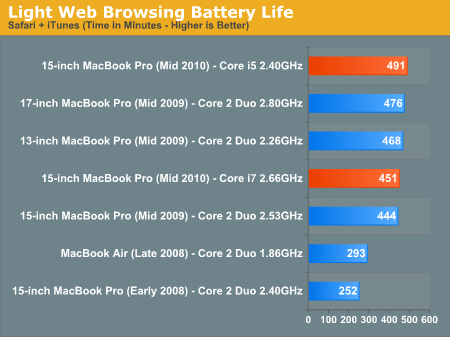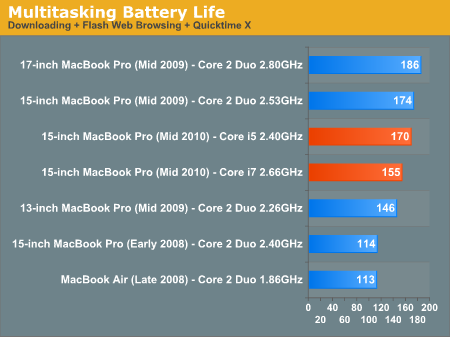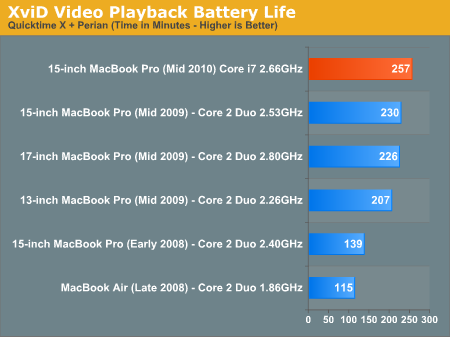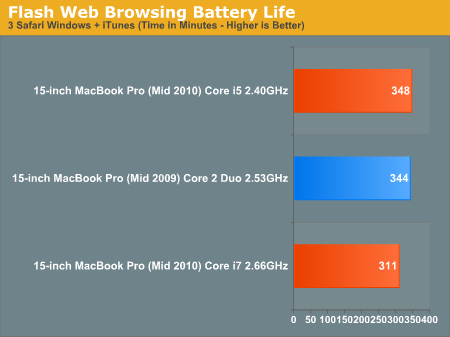Apple's 15-inch 2010 MacBook Pro: More Battery Life Tests, High Res Display Evaluated
by Anand Lal Shimpi on April 24, 2010 1:57 AM EST- Posted in
- Mac
- Displays
- MacBook Pro
- Arrandale
- Laptops
Core i5 vs. Core i7 Battery Life
With access to the top-of-the-line Core i7 MacBook Pro, I decided to run comparative battery life tests between it and the entry level Core i5 system. The main difference is a higher clocked CPU and an extra MB of L3 cache. The i7 ends up being up to 15% faster than the i5, but at what detriment to battery life.
The results below echo what I’ve seen in real world usage. You generally lose a little under 10% battery life when you opt for the Core i7 MacBook Pro vs. the entry level Core i5. You do gain more than that in performance, a noticeable increase in my opinion, but if you value battery life more than performance you’re better off with the i5. If you're upgrading from the previous generation, you may actually see a real reduction in battery life depending on your workload if you go to the i7. Update: The Core i7 model we're testing also uses the high res display, which should consume more power than the low res standard display. The difference in battery life isn't just due to the CPUs but the display as well.


Note that your mileage may vary considerably here. Years ago Intel started shipping its processor families with a range of core voltage options. Two 2.66GHz Core i7s may run at wildly different core voltages, which would ultimately impact battery life. It’s possible that I got a particularly bad Core i7 (or particularly good Core i5) and that you’ll see a different gap than I did.
I also ran the i7 system in the rest of our Apple battery life suite.
XviD Video Playback
I ripped The Dark Knight to XviD and played it back continuously in QuickTime X with Perian installed. For this test the display was set to full brightess and audio was set at two bars below maximum. Once more the hard drive was allowed to go to sleep if it was idle. The AirPort (wireless LAN) was enabled and connected to a local access point less than 20 feet away.
XviD playback actually demonstrates our largest improvement in battery life over the previous generation. If you've got a MacBook Pro from just two years ago you'll have roughly twice the battery life with a new one.

Flash Web Browsing
The test here has three Safari windows open, each browsing a set of web pages with between 1 - 4 animated flash ads per page, at the same time. Each page forwards onto the next after about 20 seconds.
As always, the display is set to 50% brightness, audio at two bars, screensaver disabled and the hard drive is allowed to go to sleep if idle. The wireless connection is enabled and connected to a local access point less than 20 feet away.

Heavy flash web browsing is effectively no better on the new MacBook Pro compared to the old one. If you opt for the Core i7, you'll actually take a hit compared to the older MacBook Pro. You might be wondering why we don't have more historical data for our Flash web browsing battery life test. I'm glad you asked...










69 Comments
View All Comments
ltcommanderdata - Saturday, April 24, 2010 - link
It's kind of disappointing that the Core i7 takes a noticeable battery life hit compared to the Core i5 considering they both in the same 35W TDP target. Could you double check the clock speeds of the GPU in the Core i7 model? The low-end Core i5 model you previously showed a GPU-Z shot of was definitely underclocked, but perhaps that's because it's replacing the previous pure 9400M model, whereas higher model MacBook Pros might have higher clock speeds which could help explain the battery life difference.As well, since you have Windows installed on the MacBook Pros, could you do your round of mid-range laptop gaming comparison benchmarks as was done for the ASUS G73Jh? People don't buy MacBook Pros specifically to game, but people with MacBook Pros no doubt do play games, so I think it'll be useful information. Running it against the Mid-2009 17" MacBook Pro you have would also be good to see the improvement of the GT330M over the 9600M GT.
I'm also curious to see if the limited thermal room of the MacBook Pro limits the effectiveness of Turbo Boost. It might be interesting to chart the CPU frequency of the Core i7 over an hour as it cycles through an intensive benchmark to see if it can hit the top Turbo Boost bin (3 bins for 2 cores) and how long it can sustain that before the heat sinks saturate and the clock drops back down to normal. Of course, without comparison to other laptops with more thermal room, it's hard to tell the "normal" or optimal Turbo Boost behaviour of the Core i7, but it should be something manufacturers should consider to differentiate themselves from others using the same components.
aj28 - Saturday, April 24, 2010 - link
Anand,Pardon if you've already covered this and I missed it, but have you done any tests comparing the effects on battery life by the use of Flash 10.1 versus Flash 10.0 on any of the Apple/Optimus GPU-switching i5/i7 notebooks? If Flash 10.1 kicks on the dGPU, is there a chance that the i5 might be able to power through it with ease to the point that you could actually get better battery life by not using GPU acceleration?
I know that goes against common wisdom, and I'm sure you would be better off if we were talking about a low-power integrated chip, but it seems to me that the mid-to-high-end dGPU chips are horribly inefficient for this type of thing in cases like these where they can, unlike a desktop, simply be switched off completely in favor of an iGPU which has to be powered all the time anyway, even if in a low-power state.
Thanks for your reply if you get around to it!
flgt - Saturday, April 24, 2010 - link
I think you've already stated why they won't put much effort in OS X. It's a huge population of STUDENTS. And students don't generate revenue like fat corporate and government accounts.I’m sure the Mathworks don’t want to artificially limit their customer base, but if it is coming down to a decision between OS X or Windows/Linux it’s obvious which one will take priority.
For the vast amount of companies Windows and Linux deliver equivalent or better hardware at much better price points. They also host more of the client applications that drive productivity, which could be argued to be more important than the OS itself.
You could argue it is important to reach students who one day might be paying corporate users, but if a student learns MATLAB on their Mac they can easily be just as productive on a corporate PC. There is no real incentive to make the experience better for a minority of non-paying users.
mbene12 - Sunday, April 25, 2010 - link
I know it is totally off topic, but this is exactly why I left Matlab for python. Their lack of native Mac support. As I transitioned from student to professional I just didnt see a reason to pay $4000 a year for base license and libraries which performed poorly when I could get most of what I needed done in a mix of Python and C for free.erple2 - Monday, April 26, 2010 - link
I think that thinking is a double edged sword. Students (and more importantly, Universities) are a major piece of the Matlab licensing revenue. I know that the Educational discount is pretty decent, but that's still a significant chunk of change. I'd wager that if you looked at the total number of licenses the Mathworks distribute, Education would be an even player with Corporate and Government levels.The other argument (that you can get more hardware for the money) has (almost) always been the case with Apple, however. There were a few notable exceptions (Apple had the first Core2 based desktops and laptops - I can't remember if they were on the forefront with the i7 based desktops, though), plus when DDR3 first came out in a SODIMM format, Apple was curiously reasonably priced.
rawd - Saturday, April 24, 2010 - link
Hi Anand, Cody Kreiger on Macrumors has already written an app to monitor GPU usage and it resides in the taskbarhttp://codykrieger.com/gfxCardStatus.app.zip
bitninja - Saturday, April 24, 2010 - link
Thanks for the mention rawd! Anyone interested in seeing the MacRumors forum thread where it's being discussed and fleshed out can visit it below until I get a formal page up on my website:http://forums.macrumors.com/showthread.php?t=90152...
Thanks, be sure to leave a comment with your thoughts if you try it out!
Cody
rcocchiararo - Saturday, April 24, 2010 - link
Is it posible to get a 15 inches macbook pro with a glossy/matte high res display from, lets say.. amazon/bestbuy/newegg/whatever ?or only directly from apple ?
Computer Scooter Joe - Saturday, April 24, 2010 - link
Thanks for the info, just one more question. Do the fans spin up as a result of the dGPU being on? Or are they generally fairly quiet?I understand that it depends on the application, but im talking about just idiling at desktop or web browsing or working in Word.
maxxl - Saturday, April 24, 2010 - link
I can't post this command here unfortunately, becouse of an error that appears when I try to, so look at this thread for "ioreg -lw0" command:http://discussions.info.apple.com/message.jspa?mes...
With the model number you can find manufacturer easily, i.e. here:
http://www.beyondinfinite.com/library.html
Best reards,
Max